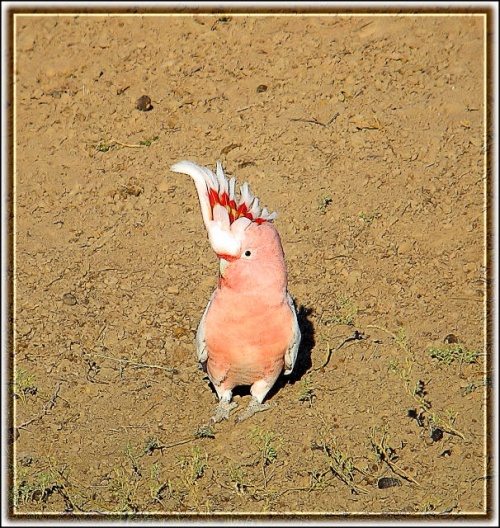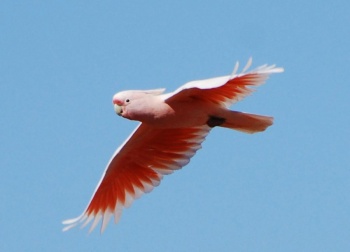(genus change) |
(→External Links: Multiple GSearches combined) |
||
| (7 intermediate revisions by 3 users not shown) | |||
| Line 1: | Line 1: | ||
| + | [[Image:Pink_Cockatoo.jpg|thumb|500px|right|Photo by {{user|Recurvirostra|Recurvirostra}} <br /> [[Mungo National Park]], south-western [[New South Wales]], [[Australia]], April 2006]] | ||
'''Alternative name(s): Pink Cockatoo''' | '''Alternative name(s): Pink Cockatoo''' | ||
;[[: Category:Lophochroa|Lophochroa]] leadbeateri | ;[[: Category:Lophochroa|Lophochroa]] leadbeateri | ||
| − | |||
==Identification== | ==Identification== | ||
| + | 33–40 cm (13-15¾ in) | ||
*White and salmon pink plumage | *White and salmon pink plumage | ||
| − | *Red and yellow crest | + | *Red and yellow crest<br /> |
| + | '''Female''': has a red iris and broader yellow band in the crest | ||
==Distribution== | ==Distribution== | ||
| + | [[Image:Major Michell s Cockatoo 00000001.jpg|thumb|350px|right|Female<br />Photo by {{user|Ken+Doy|Ken Doy}}<br />SW [[Queensland]], October 2017]] | ||
Endemic to [[Australia]]: found in [[New South Wales]], [[Northern Territory]], [[Queensland]], [[South Australia]], [[Victoria]] and [[Western Australia]]. | Endemic to [[Australia]]: found in [[New South Wales]], [[Northern Territory]], [[Queensland]], [[South Australia]], [[Victoria]] and [[Western Australia]]. | ||
==Taxonomy== | ==Taxonomy== | ||
| − | Pink Cockatoo was formerly placed in the genus ''[[: Category:Cacatua|Cacatua]]'', but all available evidence suggests placement of this species in the monotypic genus ''Lophocroa'' (Brown & Toft, 1999). | + | Pink Cockatoo was formerly placed in the genus ''[[: Category:Cacatua|Cacatua]]'', but all available evidence suggests placement of this species in the [[Dictionary_M-O#M|monotypic]] genus ''Lophocroa'' (Brown & Toft, 1999). |
| − | ====Subspecies | + | ====Subspecies==== |
| − | [[Image:IMG 0489 4 .jpg|thumb|350px|right|Juvenile<br />Photo by {{user|Tiger1|Tiger1}}<br />Eyre Bird Observatory, [[Western Australia]], June 2009]] | + | [[Image:IMG 0489 4 .jpg|thumb|350px|right|Juvenile<br />Photo by {{user|Tiger1|Tiger1}}<br />[[Eyre Bird Observatory]], [[Western Australia]], June 2009]] |
| − | Two subspecies are recognized: | + | Two subspecies are recognized<sup>[[#References|[1]]]</sup>: |
*''L. l. mollis'': | *''L. l. mollis'': | ||
:*Western [[Australia]] | :*Western [[Australia]] | ||
| Line 17: | Line 20: | ||
:*Central and east-central [[Australia]] | :*Central and east-central [[Australia]] | ||
==Habitat== | ==Habitat== | ||
| − | |||
Mallee woodland near water, eucalypt scrub, sparsely timbered grassland, woodland and mulga scrub. | Mallee woodland near water, eucalypt scrub, sparsely timbered grassland, woodland and mulga scrub. | ||
==Behaviour== | ==Behaviour== | ||
Locally nomadic. | Locally nomadic. | ||
====Diet==== | ====Diet==== | ||
| − | + | [[Image:Mm3b.jpg|thumb|350px|right|Photo by {{user|nightparrot|nightparrot}}<br />Freshwater Bore, Newhaven Station, [[Northern Territory]], [[Australia]], June 2008]] | |
| − | + | They feed on a wide variety of seeds and fruit, including the seeds of the Paddy Melon (Cucumis myriocarpus) and the fruits of Bloodwood (Corymbia spp.) and Desert Oak (Allocasuarina decaisneana), also on seeds of acacias and chenopods (e.g., saltbush). | |
==References== | ==References== | ||
| − | #{{Ref- | + | #{{Ref-Clements6thAug17}}#Avibase |
| + | #BF Member observations | ||
#Wikipedia | #Wikipedia | ||
| + | #Handbook of the Birds of the World Alive (retrieved Oct 2017) | ||
{{ref}} | {{ref}} | ||
==External Links== | ==External Links== | ||
| − | {{GSearch| | + | Search the Gallery using the scientific name: |
| − | {{ | + | {{GSearch|"Lophochroa leadbeateri" {{!}} "Cacatua leadbeateri" {{!}} "Major Mitchell's Cockatoo" {{!}} "Pink Cockatoo"}} |
| + | {{GS-checked}}1 | ||
| + | <br /> | ||
| + | <br /> | ||
| + | |||
[[Category:Birds]][[Category:Cacatua]] [[Category:Lophochroa]] | [[Category:Birds]][[Category:Cacatua]] [[Category:Lophochroa]] | ||
Latest revision as of 23:47, 20 November 2023
Alternative name(s): Pink Cockatoo
- Lophochroa leadbeateri
Identification
33–40 cm (13-15¾ in)
- White and salmon pink plumage
- Red and yellow crest
Female: has a red iris and broader yellow band in the crest
Distribution
Endemic to Australia: found in New South Wales, Northern Territory, Queensland, South Australia, Victoria and Western Australia.
Taxonomy
Pink Cockatoo was formerly placed in the genus Cacatua, but all available evidence suggests placement of this species in the monotypic genus Lophocroa (Brown & Toft, 1999).
Subspecies
Two subspecies are recognized[1]:
- L. l. mollis:
- Western Australia
- L. l. leadbeateri:
- Central and east-central Australia
Habitat
Mallee woodland near water, eucalypt scrub, sparsely timbered grassland, woodland and mulga scrub.
Behaviour
Locally nomadic.
Diet
They feed on a wide variety of seeds and fruit, including the seeds of the Paddy Melon (Cucumis myriocarpus) and the fruits of Bloodwood (Corymbia spp.) and Desert Oak (Allocasuarina decaisneana), also on seeds of acacias and chenopods (e.g., saltbush).
References
- Clements, J. F., T. S. Schulenberg, M. J. Iliff, D. Roberson, T. A. Fredericks, B. L. Sullivan, and C. L. Wood. 2017. The eBird/Clements checklist of birds of the world: v2017, with updates to August 2017. Downloaded from http://www.birds.cornell.edu/clementschecklist/download/
- Avibase
- BF Member observations
- Wikipedia
- Handbook of the Birds of the World Alive (retrieved Oct 2017)
Recommended Citation
- BirdForum Opus contributors. (2024) Major Mitchell's Cockatoo. In: BirdForum, the forum for wild birds and birding. Retrieved 23 May 2024 from https://www.birdforum.net/opus/Major_Mitchell%27s_Cockatoo
External Links
Search the Gallery using the scientific name:
GSearch checked for 2020 platform.1







